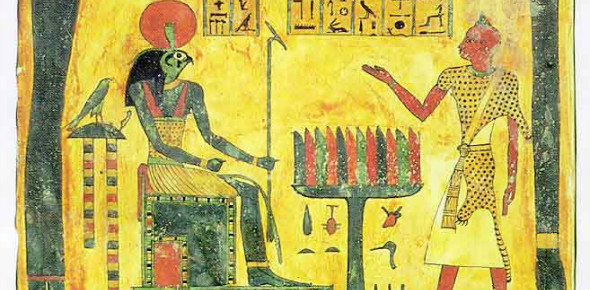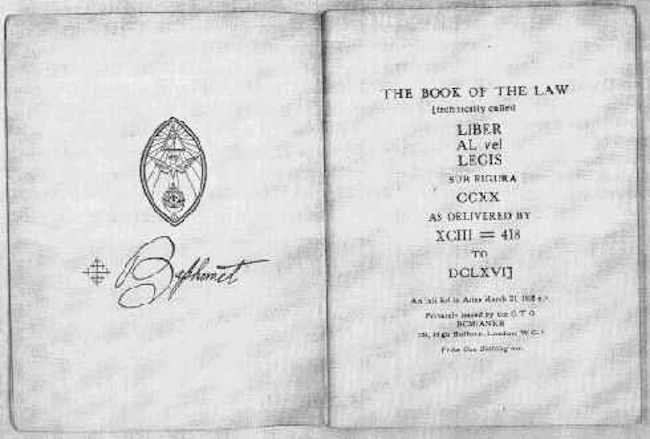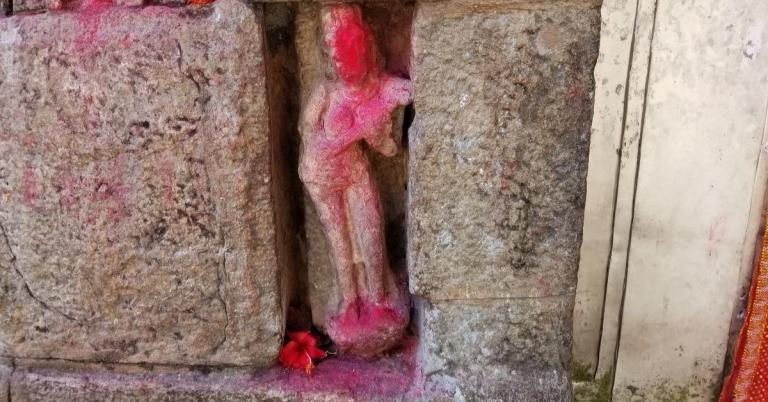If you are interested in what we know about the object itself, you’ll want to read The Stele of Revealing, Part 1 – A Funerary Stele.
When Crowley saw this object he did not immediately recollect an image of a past life. His identification with the priest of the stele emerged as the entity Aiwass dictated to him Liber al vel Legis, the Book of the Law. Chapter I says:
35. This that thou writest is the threefold book of Law.
36. My scribe Ankh-af-na-khonsu, the priest of the princes, shall not in one letter change this book…
Crowley was the scribe, so he must have been Ankh-f-n-khonsu. He was familiar with the doctrine of reincarnation through his studies with fellow Golden Dawn member Alan Bennett, who shared his extensive knowledge of Buddhist and Hindu scriptures.
Buddhism seems to have come to Egypt about the time of Alexander the Great, several centuries after the death of Ankh-f-n-khonsu. There were Buddhist temples in the city of Alexandria, and reincarnation was a doctrine known to the philosophers of that city. As an English gentleman with a classical education Crowley studied those works of the Alexandrian philosophers which survived through time.
Reincarnation was not a doctrine known to Ankh-f-n-khonsu himself. In Kemetic/Egyptian religion, the soul did not leave the body and then return in a different body. Instead, ritual performed after death united several parts of the soul in a new spiritual-material form which travelled from the land of the dead to the land of the living every day, just as the sun did. The deceased was anchored to the living world by a mummified body, or by an image of the person while alive, or even by the rememberance of their name.
Thelemites visiting the Cairo Museum in 2004 found a mummy labelled Ankh-f-n-khonsu. This mummy was intended to secure the eternal life of that person. Similarly, the funerary stele of Ankh-f-n-khonsu was intended to give him a virtual tomb within which to rest and provide him the eternal food piled on the offering table. He is still with us. He is still there. We know where he is, physically in the holdings of the Cairo Museum, calling his united soul forth by day to travel with the sun back to the land of the living.
So when Ankh-f-n-khonsu stands in the body of Aleister Crowley to view his own funerary stele, we’ve jumped worldviews. Has something gone wrong? Did the religious ritual, the magic, of the funerary stele fail?
Science tells us that the mind dies with the body, and treats both Kemetic and Buddhist thought as forms of wishful thinking to stave off the fear of the end of material existence. Catholic theology resembles Kemetic more closely than Buddhist, holding that the soul inhabits a realm after death (Heaven, Hell or Purgatory), and that at the end of days the soul will return to Earth to be reunited with its physical body, now made eternal. Nearly everyone in the English speaking world is familiar with all these competing conceptions of life after death and we are accustomed to knowing several views which contradict each other.
We may decide to simply inhabit both worldviews, granting Ankh-f-n-khonsu his eternal life while simultaneously granting Aleister Crowley as a reincarnation of that priest. We may decide that the Egyptian worldview was in error and that Ankh-f-n-khonsu discovered this upon his next rebirth. We may craft a sophisticated theological response which would divide the soul, one part to engage in its journey with the sun, another to be reborn in a succession of human bodies.
In The Gnostic Mass, Annotations and Commentary, Helena and Tau Apiryon note that Crowley as Ankh-f-n-khonsu was the living prophet of the Aeon of Horus, and that the stele has an oracular connection to the reception of the Book of the Law and the Law of Thelema. This transformation renewed the energies of ancient Egypt in the pattern of aeonic evolution.
However we frame the transformation, what is certain is that Crowley repurposed the stele. Instead of anchoring the travels of the soul from the realm of the dead to the living, it anchors the spiritual awakening of the Book of the Law. The image of Nut becomes Nuit, the star goddess; the solar disk becomes Hadit; Re-Horakhty becomes Ra-Hoor-Khuit. The stele itself is reproduced in physical form and sits on top of the altar during the Gnostic Mass, an altar which reproduces the structure of the cosmos.
There is an overtone of colonialism here. Crowley benefitted from the power and privilege of the British empire; he didn’t question his right to appropriate the image of the stele for his own purposes. When I viewed the stele in the Cairo museum in 2008, the only other person in the room was a young woman wearing a hijab; she was kneeling on the floor painting the stele on a papyrus sheet, and fled on my arrival before I could speak to her. This was a cross-cultural encounter with colonialist implications – my religious experience was her cultural heritage, which she was practicing to sell back to tourists like me.
However, her cultural heritage was not her religious experience, and my religious experience was conducted privately in a non-religious context. Our sacred object is the museum’s physical property. Egypt is an Islamic country, and while tourism is a critical industry, it is tourism limited to admiring objects in a cultural or scientific framework. When the Temple of Thelema became aware the stele had been removed in 2011, members warned each other not to query the museum’s authorities and alert them that this object has meaning to us, implying a fear that the museum may choose to lock it out of sight permanently.
Since the Gnostic Mass requires the stele as part of the altar equipment, and since the stele is so important to Thelema, several artists sell full and partial size reproductions. Both sides of the stele are reproduced in The Equinox Vol. I No. VII, and people often photocopy these and paste them onto foamboard or wood. O.T.O. Eire has made available Cathryn Orchard’s line drawing in black and white for individuals to color in themselves, for learning, and as an act of devotion.
Whatever our reason for reproducing the stele, the image lives on, and the name of Anhk-f-n-khonsu is remembered thousands of years after his death, a form of immortality the stele was meant to ensure. Viewed in that light the magic has been wildly successful.
Read more:
Temple of Thelema public discussion, The Stele of Revealing has been moved.
Kaczynski, Richard, Ph.D. (2002).



